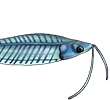https://academic.oup.com/zoolinnean/art ... 59/7706052
Key words: cascudos, DNA barcode, Neotropical fish, new species, Parnaíba RiverAbstract
Hypostomus is the most species-rich genus within the family Loricariidae and is widely distributed throughout the Neotropical region. Nonetheless, the diversity and distribution of these species have still large knowledge gaps. This scenario is more significant in some regions, such as the northeast of Brazil. In this region, the first species of the genus, H. pusarum, was described in the Northeast Caatinga and Costal Drainages ecoregion. Six congeners were subsequently described in the same ecoregion, all sharing the same colour pattern making them difficult to distinguish. All of them are collectively referred to as the H. pusarum complex. The present work seeks to clarify the diversity that constitutes the H. pusarum complex through an integrative study using molecular and morphological data. The results indicate that H. carvalhoi, H. jaguribensis, H. nudiventris, H. papariae, and H. salgadae are all junior synonyms of H. pusarum. However, one of the morphotypes that occurs in the Parnaíba River is a new species that differs from the others by the absence of a developed medial buccal papilla and the presence of a pre-anal plate. The data provided here highlight the importance of integrative taxonomy for assessing diversity in complex and diverse groups in the Neotropics.





